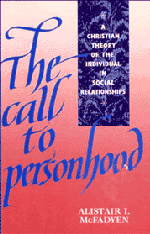Book contents
- Frontmatter
- Contents
- Acknowledgements
- Introduction
- Part I Persons in relation to God
- 1 The creation of individuality in God's image: Trinity, persons, gender and dialogue
- 2 The re-creation of individuality: the call of Christ
- Part II Social relations
- Part III Interpersonal relations
- Part IV Political relations
- Epilogue
- Notes
- Glossary
- Index
1 - The creation of individuality in God's image: Trinity, persons, gender and dialogue
Published online by Cambridge University Press: 03 May 2011
- Frontmatter
- Contents
- Acknowledgements
- Introduction
- Part I Persons in relation to God
- 1 The creation of individuality in God's image: Trinity, persons, gender and dialogue
- 2 The re-creation of individuality: the call of Christ
- Part II Social relations
- Part III Interpersonal relations
- Part IV Political relations
- Epilogue
- Notes
- Glossary
- Index
Summary
The two major theological components in my argument are human existence in the image of the trinitarian God and the call of Christ. In this chapter I shall discuss the first of these. In doing so, I shall not attempt to develop afresh the Christian doctrines of the Trinity, creation, fall and redemption which are woven into the argument. That would be far beyond the scope of this book. Instead, I shall take a mainstream, orthodox position on them, as represented by various modern theologians (to whom I refer in the notes), and shall redescribe and reinterpret this orthodox position in relation to the subject of the book. Basic Christian conceptions, and their distortions, have in fact deeply influenced modern understanding of personhood. It should therefore be no surprise that bringing a contemporary interpretation of these Christian doctrines into dialogue with modern thought and its dilemmas concerning personhood is a fruitful exercise.
I describe the image first of all in its ‘vertical’ dimension as the constitution of human beings through relation to God, with grateful and praise-giving response as the normative form of this relation. I then turn to the ‘horizontal’ dimension of the image in the sphere of human relations. This produces a fundamental understanding of the person in social categories in which the relations between the sexes are of primary importance. The reconception of ‘the fall’ which concludes the chapter points to a way of conceiving the radical distortions of human existence which are a part of our mundane reality.
- Type
- Chapter
- Information
- The Call to PersonhoodA Christian Theory of the Individual in Social Relationships, pp. 17 - 44Publisher: Cambridge University PressPrint publication year: 1990

